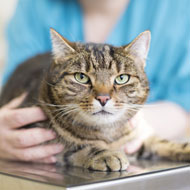Acute pain is adaptive, chronic pain is not

Whilst there can be a certain amount of adaption to chronic pain, this does not mean that the animal has got used to it.
The assessment of chronic pain and suffering relies on an assessment of emotion, said veterinary surgeon Samantha Lindley during a lecture at London Vet Show. Although she was referring to human pain, the definition of pain as being whatever the patient says it is set the scene for the rest of her lecture.
The first dilemma when treating chronic pain in animals is whether you are treating pain or the anxiety caused by it, as one affects the other so much.
Radiographs can show you the physical effect of pain but they cannot tell you about the degree of pain, so although you may be able to identify the problem and its cause, you cannot assess the actual amount of pain.
It is also important to bear in mind that pain perception is dependent upon the emotion and the circumstances; one emotion can override another, so sometimes this will affect the degree of pain.
The components of pain:
- Sensory - recognising pain
- Emotional - the effect of pain
- Cognitive - thinking about the pain
- Motor - how pain affects movement
It can be useful to look at which component is the most important for the patient and to target this first.
Pain is frightening and because the animal will be frightened, there may be various behaviours exhibited. But what we cannot do is teach the pet not to be frightened of their pain.
Whilst there can be a certain amount of adaption to chronic pain, this does not mean that the animal has got used to it. Furthermore, it is true to say that the coping mechanisms animals use can have a positive and/or a negative impact on the animal's behaviour and relationship with its owner.
Any kind of behaviour change can be because of pain but there may also be other environmental reasons. So the lesson to learn is that, in the evaluation of pain, nothing is definite.
As was explained in a previous pain lecture earlier in the day - ‘The strain of pain lies mainly in the brain' - chronic pain is a stressor and causes all the same physiological changes as chronic stress.
We rely on behavioural changes to recognise pain but must not forget the behavioural preferences of the animal when assessing the extent of suffering.
There are many validated pain scoring systems but Samantha uses triangulation to assess pain, looking at three factors:
- Presenting signs
- Behaviour
- Gait/ examination
Two final pieces of advice given were:
1. If an animal has had long term pain their behaviour will not have changed perhaps for years and may therefore not be recognised by their owner.
2. Just because a patient is relatively young, it does not negate the possibility that they may be suffering from chronic pain.



 The RCVS has announced a new version of its 1CPD mobile app, with enhanced features for veterinary surgeons and veterinary nurses to record their continuing professional development.
The RCVS has announced a new version of its 1CPD mobile app, with enhanced features for veterinary surgeons and veterinary nurses to record their continuing professional development.